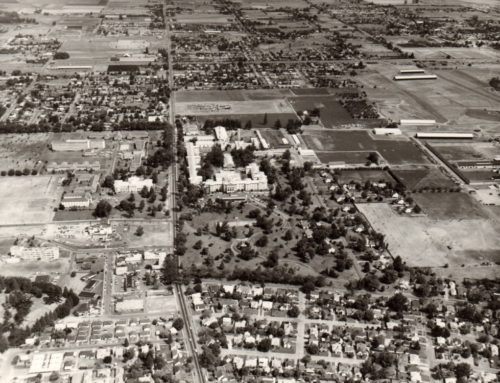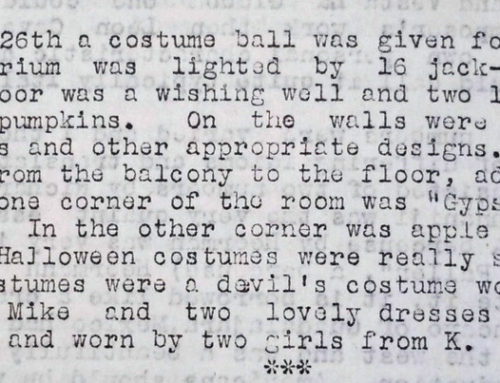This is an excerpt from the Oregon Teacher’s Monthly magazine published in May 1916 (volume 20, no. 9). Oregon Teacher’s Monthly featured articles written by teachers, students and administrators related to general interest topics and had a news section with a county by county listings of school-related events. We came across this issue in the holdings of the Oregon State Library. This excerpt is chapter 10 in a series of articles written by Frank K. Welles, Assistant State Superintendent of Public Instruction, on state institutions. The information he presents appears to have come from studying published reports of the hospital and a personal tour.
OUR OREGON STATE INSTITUTIONS
The Oregon State Hospital
Some of the school children who will read this article have never visited a hospital for the insane and will be interested to know what such an institution looks like, how the hundreds of patients are cared for, what they do and how they live. The modern hospital for the insane is quite a different institution from what it used to be. Now it is indeed a hospital for the treatment of persons with deranged minds, most of whom also have some physical ailment, rather than simply an asylum for the detention and safe-keeping of the insane.
Oregon has two hospitals for the insane. One is situated just east of the city limits of Salem and the other is a short distance west of Pendleton in Umatilla county. The Eastern Oregon State Hospital was built during 1911 and 1912 and is modern in every respect. As soon as this institution was completed, 325 patients were transferred to it from the Salem hospital in order to relieve the over-crowded condition at the latter place. As far as possible, the insane from Eastern Oregon are sent to Pendleton and those from Western Oregon to Salem. The number of insane is increasing so rapidly that the last legislature authorized the construction of a new $100,000 wing to the Pendleton hospital. This has recently been completed. There is also a fine farm in connection with that institution. The last report of the superintendent shows that there are now about 379 insane persons at the Pendleton hospital.
The Oregon State Hospital at Salem is an older and much larger institution. It was established in 1880. Besides the administration building which has two wings, there is a new receiving ward for female patients and an infirmary, besides numerous cottages, barns, greenhouses and many other buildings. There is a branch of the institution situated five miles southeast of Salem, known as Cottage Farm. Here there are five cottages occupied by patients, besides several barns, a modern dairy, an evaporating plant, and other buildings. Cottage Farm and the grounds at Salem comprise 1455 acres of land, nearly all of which is tilled. The Oregon State Hospital is well situated on a high elevation of land overlooking the city. The ample grounds with their fine trees, beautiful flowers and paved driveways, form a veritable park which it is a great delight to visit.
A Large Institution
The Oregon State Hospital for the insane is by far the largest of the state institutions. When I visited this institution there were 1644 patient, besides about 200 officers, attendants and other employees. The principal building is three stories high and has two immense wings which are also three stories in height. The wing occupied by the male patients is a quarter of a mile long. Some idea of the great size of the building can be gained from the fact that one would walk more than two miles in going through all of the wards. In this building alone there are 1277 windows. All of the buildings are heated from a central plant which is situated a safe distance from the other buildings. Formerly the main building was heated by 32 separate furnaces. They were superseded by the central heating plant to lessen the danger of fire and to save labor. The heating plant burns crude oil. Its immense concrete smoke stacks stand 150 feet high and cost $3000.
I spent four hours in visiting this institution. Part of the time I was accompanied by the superintendent personally, and part of the time by one of his assistants. I found that nearly all of the patients do some kind of useful work. Although no one is forced to work against his will, almost everyone can be persuaded to do something useful. This adds much to their health and happiness. The work is so well organized that the patients do much toward supporting the institution. For instance, in the laundry, where the laundrying for all of the patients and the employees is done (over 2,000 persons in all) I found about fifty patients employed under the supervision of a laundryman and two or three assistants. The men were doing the heavier work and in another portion of the building, the women were ironing. In one of the industrial departments for women, I found patients operating twenty sewing machines. Many others were employed at needlework, rug-making and basketry. Most of the bed-linen, as well as the clothing worn by the patients, is made in the instruction. Besides this department and the laundry which I have already mentioned, there is a large bakery, shoe factory, blacksmith shop and carpenter shop. In all these departments the patients work under the direction of a few skilled supervisors. In the bakery I saw an excellent quality of fresh bread piled up in cords ten feet high. It requires 1350 loaves of bread and 690 biscuits every day. The food is carried from the kitchen on cars that run on a little railroad tracks through tunnels which run under all the buildings.
The Farm is Productive
Large numbers of patients are also employed on the farm and about the grounds. The products of the farm, garden and dairy amount to more than $60,000 annually. The superintendent’s report shows that during the biennial period almost every kind of farm and garden product was produced in immense quantities. For instance, 55,318 pounds of green beans, 71,301 cabbages, 32,006 bushels of potatoes, and 9218 gallons of strawberries were raised. The hogs produced 83, 162 pounds of pork and the cows 141,301 gallons of milk, while the hens laid 16,930 dozens of eggs. The dairy barn and milk houses are models of convenience and neatness, and the same may be said of the pig pens where between 450 and 500 hogs and pigs are kept. About 83 cows, most of which are Holsteins, are now being milked. The farm produces great quantities of fruits. Some of the fruit is evaporated for winter use. In the evaporating plant I saw tons of evaporated apples, prunes, and logan berries and counted 27 barrels of vinegar. The business is so well managed that the cost of keeping each patient, including food, clothing, nursing and medical attention, is less than $15 per month. In the poultry plant I found a number of large incubators and about two thousand little chicks, from a few hours to several weeks old. They expect to raise ten thousand chickens during the season. When we remember that it requires four to five hundred chickens for a single meal, this does not seem like such a large number.
How the Insane are Committed
Before a person may be committed to a hospital for the insane it is necessary for someone to file a complaint with the county judge of the county in which the person who is suspected of insanity, lives. The judge then calls in one or more physicians who make an examination. IF the person is found to be insane, the judge issues the commitment papers and the state hospital is notified to send a male or female attendant, as the case may be, to take the patient to the hospital. In making the commitment, the probable cause of insanity is always given. Of the 1198 persons committed to the Salem hospital during the last two years, the cause, in more than half of these cases was given as unknown. In all, 60 different causes were assigned. Seventy-three of the cases were attributed to worry, 70 to alcohol, 42 to sickness and 23 to injury. However, I was told by the superintendent that by far the greatest umber of cases of insanity are due to heredity. The number of patients who recover is comparatively small. Of the 1249 who were received during the two years covered by the superintendent’s last biennial report, 271 patients were discharged as cured and 192 as greatly improved. The oldest person now in the Salem hospital is a woman of 97 years. In rare cases children of ten and twelve years have been committed. Although there are several patients now living, who were committed nearly fifty years ago, the patients live and average of about 10 years after being committed. This time is being gradually lengthened, due to better facilities and better methods of treatment.
Amusements and Recreation
The wards occupied by the patients are light and cheerful as they can be made, and everything is scrupulously clean. The wards in which the milder cases are kept have beautiful potted plants. There patients are supplied with the daily papers and other reading matter. They spend part of their leisure time in reading and playing games. Church services are held every Sunday in the chapel for those who are able to attend. A moving picture entertainment is given once a week and on one evening each week there is a dance, the music for which is furnished by the employees. The employees have an excellent brass band in which there are about twenty musicians.
Many Employees are Required
The employees are classified in the superintendent’s last report as follows: One superintendent and five assistants, all of whom are physicians, eight officers, 80 male attendants, 55 female attendants, 57 department employees and 15 farm laborers. The male attendants begin with salaries of $30 per month and female attendants $25. These salaries are increased $5 every three months until the maximum of $50 per month is reached. They also receive their board, rooms and laundry work in addition to their salaries. The institution has a pharmacist and is well supplied with drugs and medicines. There is also a dentist who keeps the teeth of the patients in good condition, thus adding greatly to their health and comfort.
In addition to having fire escapes, the buildings are all provided with sprinklers which operate automatically in case of fire. A great many people visit the hospital for the insane. Visitors are received between 10:00 and 12:00 in the forenoon and 2:00 and 4:00 in the afternoon on every day excepting Saturdays, Sundays and holidays. Near relatives are permitted to visit the institution on Sundays also between the hours of 10:00 and 12:00 in the forenoon. The state board of control, consisting of the governor, secretary of state and the state treasurer, have immediate control of this, as well as of all the other state institutions. These officials make frequent visits of inspection for the purpose of assuring themselves, as well as the many friends and relatives who are interested, that everything possible is being done to promote the health and happiness of these unfortunate persons.



